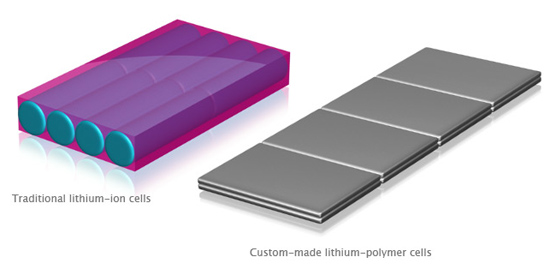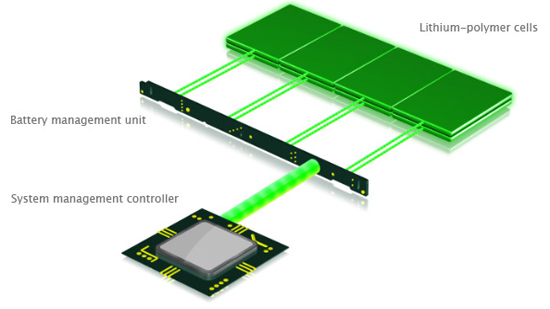Apple's 2009 MacBook Pro: Battery Life to Die For
by Anand Lal Shimpi on June 12, 2009 12:00 AM EST- Posted in
- Mac
I was so focused on the iPhone 3GS and Snow Leopard announcements from this year’s WWDC that I almost missed the gravity of the MacBook Pro announcements.
Apple announced price drops on nearly all of its laptops. The new lineup looks like this:
| MacBook | MacBook Pro 13-inch | MacBook Pro 15-inch | MacBook Pro 17-inch | |
| CPU | Core 2 Duo 2.13GHz | Core 2 Duo 2.26GHz | Core 2 Duo 2.53GHz | Core 2 Duo 2.8GHz |
| GPU | NVIDIA GeForce 9400M | NVIDIA GeForce 9400M | NVIDIA GeForce 9400M | NVIDIA GeForce 9400M + 9600M |
| Memory | 2GB DDR2 | 2GB DDR3 | 4GB DDR3 | 4GB DDR3 |
| HDD | 160GB | 160GB | 250GB | 500GB |
| Battery Life | Up to 5 hours | Up to 7 hours | Up to 7 hours | Up to 8 hours |
| Price | $999 | $1199 | $1699 | $2499 |
If you want an all aluminum body, you have to buy a MacBook Pro. There’s only a single MacBook model and it’s the white chassis that’s been around for a while now.
Apple added a 13” MacBook Pro to the lineup to fill in the gap, although it’s not clear to me whether this 13” MacBook Pro uses the same LCD panel as the old 13” aluminum MacBook or a derivative of the 15” MacBook Pro’s panel, which is superior.
 Of course there are different models within each one of these categories that you can purchase, but they are irrelevant to the discussion we’re about to have. Look at the battery life row in the table above; Apple is claiming up to 7 hours of battery on the new MacBook Pros. The old specs used to be up to 5 hours.
Of course there are different models within each one of these categories that you can purchase, but they are irrelevant to the discussion we’re about to have. Look at the battery life row in the table above; Apple is claiming up to 7 hours of battery on the new MacBook Pros. The old specs used to be up to 5 hours.
Apple did some clever work on its own here. Standard lithium ion batteries are made up of cylindrical cells, similar to AA batteries. The problem with these batteries is that they waste a lot of space within a notebook (try cramming a lot of cylinders into a box, you end up with wasted space). This wasted space translates into larger batteries than are necessary, which makes for larger notebooks.
In order to continue to drive laptop thinness down, Apple started experimenting with using custom lithium polymer batteries instead of the industry standard lithium ion parts. Lithium polymer cells aren’t made of cylindrical cells (they’re rectangular), so there’s no wasted space. Not only does this make the batteries more compact, but it also gives you greater capacity since you’re using all available chassis volume for the battery.

Makes sense. Courtesy, Apple.
Apple also found that it was wasting space in the removable enclosure for the batteries as well, so its lithium polymer offerings are no longer user removable. I suspect this part of the equation has more to do with cutting costs than saving space though.
Apple first used this lithium polymer battery technology in its MacBook Air. It gave Apple a very thin battery that allowed it to create the MacBook Air’s sweet form factor. Then came the new 17” MacBook Pro, without a removable battery. Apple claimed that this battery would last for five years before it needed replacing and resulted in up to an 8 hour battery life.

The extended life is supposedly due to an on-battery sensor that communicates with the system's management controller that can dynamically sense the needs of each lithium polymer cell and feed that info back to the charging circuitry. The result is slight variations in charging current designed to optimally charge each and every cell; apparently reducing wasted charge cycles significantly. Apple claims that most cells will hit 80% of their life after 200 - 300 charge cycles, but its special lithium polymer batteries will hit the 80% mark after as many as 1000 charge cycles. Apple claims its unique battery chemistry and microprocessor managed charging (Adaptive Charging) is responsible for these gains but it’s a difficult statement to prove; we’ll have to wait and see what happens after a few years of use.










113 Comments
View All Comments
Pirks - Saturday, June 13, 2009 - link
C'mon man, how else winzealots could defend themselves against such a thorough and lubeless pwning by that famous fruity company? They know they lost it in a fair comparison so they try to squeeze in any old and slow Pentium era junk they can found, just to pretend to not losing a face. Hilarious! You guys keep posting here, keep the show running, gimme some atom or another shittyslow Wintel laptop, I love your lame excuses! :))) So much fun today... ahhhh...BushLin - Tuesday, June 16, 2009 - link
I have no loving affinity to any company... I like to buy good value, high performance parts, hence why I normally overlook Apple.If these rather expensive and well marketed machines could get even close to that kind of battery life under Windows I'd be impressed. Right now I just see some tests under a proprietary OS, a bunch of Fanboys with too much time on their hands who should be where they belong, in Starbucks, posing, rather than on a serious tech site.
Hacp - Saturday, June 13, 2009 - link
Samsung's new drives with the new controlelsr, the same ones that are in the ocz summit and corsair p256 have a built in cleaning function when the drives are in an idle state. This makes worst case scenario performance a non factor in these drives.iwodo - Sunday, June 14, 2009 - link
If that is true even for the 128Gb SSD that apple offer then it would be a good deal from Apple.misium - Saturday, June 13, 2009 - link
Each time a Li-ion or polymer battery is charged its capacity decreases. Li-polymer batteries deteriorate even when they are not used - just by lying on the shelf.This explains why older laptops have lower battery time - their batteries are older.
You should test the new laptop in a year or two to make a fair comparison.
Also you could just put fresh batteries into the old laptops.
Anand Lal Shimpi - Sunday, June 14, 2009 - link
All of the laptops here used brand new batteries, with the exception of the 2006 Core Duo based MacBook Pro. I did test the 2006 notebook with a new battery and found an extra ~25 minutes of battery life I believe.Take care,
Anand
peroni - Saturday, June 13, 2009 - link
The new Acer timeline laptops based on Intel CULV processors claim a battery life of 8 hours, and that's when running vista!I bet with Win7 they could squeeze an extra hour out of it.
The processor is only running at 1.4GHz but on the other hand they're very light (for the screen size)
I'd love to see an Anandtech test on them.
JarredWalton - Monday, June 15, 2009 - link
Already requested. Can't wait to see how it fares in our tests....Johnmcl7 - Saturday, June 13, 2009 - link
but then again why let niggling little things such as facts get in the way of a nice and tidy Apple marketting piece. What a load of nonsense this is from a supposedly reputable tech site right from the start:"Apple did some clever work on its own here."
Total and utter nonsense, Apple have done no such clever work at all as it's all been done already. Many years ago Ericsson showed how polymer batteries could be used to reduce size in their super slim T28 and Apple are far from the first to do so for laptops. I expect the every day person on the street to get taken in by Apple's marketting but not a site like Anandtech, I'm also surprised that the battery no longer being removeable isn't really criticised as I think that's a really bad loss. Aside from not being able to use a second battery which is very handy for those who want good batterylife and there are single batteries out there that easily exceed these Macbooks but also if you have a failure you can easily swap it out for another.
"There’s no other way to say this. If you care about battery life and portability at all, buy the new MacBook Pro. Go to the Apple store and buy one. While I only tested the 15” model, I’m guessing the 13” model should leave a similar lasting impression."
Well I had to laugh at this point although I guess it's expecting too much by now to expect AT to have any clue about other laptops on the market. I'm currently typing this on a Sony laptop I bought back in 2005 which can last around eight hours on its normal battery and on its extended battery which is currently fitted it's around 12-13 hours putting these Macbooks to shame. As the battery is also removeable both together means the machine can last a long, long time away from the mains. Why someone would want a 15.4 inch Macbook (or even 13.3in) for batterylife and portability when there's other machines that are smaller, lighter and better batterylife I've no idea - the article reads as an advert for Apple and reading the conclusion you'd think AT were on a commission from them. It must be annoying for the likes of Sony though and others who bring genuine innovation to the market, get ignored then when Apple release the same technology a few years down the line they then get all the praise for it.
djuero - Saturday, July 4, 2009 - link
Sure you're able to post links to comparable machines to prove that?